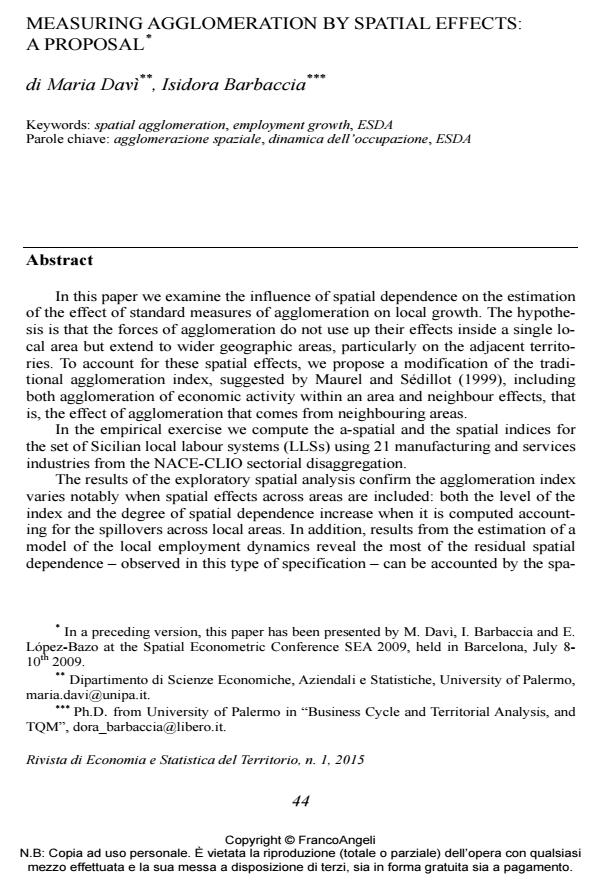Measuring agglomeration by spatial effects: a proposal
Titolo Rivista RIVISTA DI ECONOMIA E STATISTICA DEL TERRITORIO
Autori/Curatori Maria Davì, Isidora Barbaccia
Anno di pubblicazione 2015 Fascicolo 2015/1
Lingua Inglese Numero pagine 27 P. 44-70 Dimensione file 568 KB
DOI 10.3280/REST2015-001002
Il DOI è il codice a barre della proprietà intellettuale: per saperne di più
clicca qui
Qui sotto puoi vedere in anteprima la prima pagina di questo articolo.
Se questo articolo ti interessa, lo puoi acquistare (e scaricare in formato pdf) seguendo le facili indicazioni per acquistare il download credit. Acquista Download Credits per scaricare questo Articolo in formato PDF

FrancoAngeli è membro della Publishers International Linking Association, Inc (PILA)associazione indipendente e non profit per facilitare (attraverso i servizi tecnologici implementati da CrossRef.org) l’accesso degli studiosi ai contenuti digitali nelle pubblicazioni professionali e scientifiche
In this paper we examine the influence of spatial dependence on the estimation of the effect of standard measures of agglomeration on local growth. The hypothesis is that the forces of agglomeration do not use up their effects inside a single local area but extend to wider geographic areas, particularly on the adjacent territories. To account for these spatial effects, we propose a modification of the traditional agglomeration index, suggested by Maurel and Sédillot (1999), including both agglomeration of economic activity within an area and neighbour effects, that is, the effect of agglomeration that comes from neighbouring areas. In the empirical exercise we compute the a-spatial and the spatial indices for the set of Sicilian local labour systems (LLSs) using 21 manufacturing and services industries from the NACE-CLIO sectorial disaggregation. The results of the exploratory spatial analysis confirm the agglomeration index varies notably when spatial effects across areas are included: both the level of the index and the degree of spatial dependence increase when it is computed accounting for the spillovers across local areas. In addition, results from the estimation of a model of the local employment dynamics reveal the most of the residual spatial dependence - observed in this type of specification - can be accounted by the spa
I processi di agglomerazione delle attività produttive hanno suscitato l’interesse degli studiosi che hanno elaborato indicatori via via più sofisticati per spiegare le determinanti che inducono le imprese a localizzarsi in prossimità le une delle altre. Dopo una breve analisi della letteratura empirica sull’agglomerazione, che prende in considerazione anche gli effetti derivanti dai fenomeni di concentrazione a livello settoriale, in questo lavoro viene proposta una nuova misura dell’agglomerazione che tiene conto degli effetti spaziali, agenti sia all’interno che all’esterno delle singole partizioni geografiche. Le unità statistiche di base per la costruzione del nuovo indicatore sono i Sistemi Locali del Lavoro costituiti, come è noto, dal raggruppamento di comuni limitrofi, che prescindono dalle unità amministrative a cui afferiscono. La scelta di tali unità geografiche è stata effettuata con l’intento di valutare gli effetti della prossimità fisica sulla tendenza delle unità economiche a localizzarsi in determinate realtà territoriali "funzionali", come vengono definiti i SLL. Metodi e risultati L’analisi è stata condotta con riferimento ai 77 SLL siciliani, identificati sulla base dei Censimenti 1981, 1991 e 2001. Dapprima è stata effettuata una verifica della validità dell’indicatore proposto con il ricorso alle tecniche ESDA. Successivamente, il nuovo indicatore spaziale è stato incluso in un modello empirico con lo scopo di spiegare la dinamica dell’occupazione nei SLL siciliani. Nel modello sono state inserite anche alcune misure delle caratteristiche produttive e strutturali delle aree considerate quali: competizione, diversità, economie di scala, struttura produttiva e livelli di specializzazione. Il modello è stato adattato in due versioni: nella prima è presente una misura tradizionale dell’agglomerazione mentre nella seconda è stato impiegato l’indicatore spaziale, che ha prodotto effetti più interessanti del precedente. L’analisi si riferisce agli intervalli 1981-1991 e 1991-2001, a un livello settoriale corrispondente alle 21 sezioni e sotto-sezioni dell’industria e dei servizi, secondo la classificazione NACE-CLIO. Conclusioni I risultati dell’ESDA comprovano l’esistenza di un’autocorrelazione positiva quando la versione locale dell’indice di Moran viene costruita sulla base del nuovo indicatore che tiene conto degli effetti spaziali, mentre non emerge con riferimento all’indicatore standard dell’agglomerazione. Anche per quanto concerne l’influenza delle misure di agglomerazione sull’evoluzione dell’occupazione, l’indicatore spaziale ha prodotto risultati che ne hanno confermato la maggiore validità rispetto a quello tradizionale, anche se con modalità differenziate a livello settoriale e nei due intervalli censuari.
Parole chiave:Agglomerazione spaziale, dinamica dell’occupazione, ESDA
Jel codes:R12, C31, J21
Maria Davì, Isidora Barbaccia, Measuring agglomeration by spatial effects: a proposal in "RIVISTA DI ECONOMIA E STATISTICA DEL TERRITORIO" 1/2015, pp 44-70, DOI: 10.3280/REST2015-001002